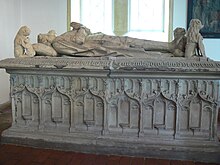Attena (family)
The Attena were a powerful East Frisian chieftain family . Your coat of arms, the right-handed, red armored black bear with a gold collar on a gold background is still part of the coat of arms of East Friesland today .
history
It is unclear whether the origins of the family lie in the north or in Dornum . The two lines must have been separated as early as the 13th century.
It is possible that the Attena came north through marriage to a daughter of the Idzinga family. Hylo Attena was the first to hold an office in the Norderland at the time of the Frisian Freedom . Together with Martin Syertza ( Cirksena ) from Berum, he occupied the Dominican church to the north and fortified it. In 1367 he was named together with Evenardus Ytzengha and Martin Syertza as "advocati terre Nordensis".
Towards the end of the 14th century, the consular constitution of the Frisian Freedom fell into disrepair. Some influential families took advantage of this situation and created a system of rule in which they, as chiefs ( hovedlinge , also capitales ), gained power over more or less large areas. In the Norderland it was the Cirksena and the Attena who aspired to power. Martin Syertza and Hylo Attena eliminated the consular constitution in the region and appeared for the first time in 1367 as capitales in the documents. It was probably also Hylo who built a stone house on today's Osterstrasse in the north , which was the nucleus of the later Ennenburg . Because of the interdependence of the sex with the Vitalienbrüder , the Hamburgers destroyed the castle together with their ally Keno II. Tom Brok in 1408 and drove the Attena from the north. They could only return as the leader of the fight against Focko Ukena , who had succeeded tom Brok and was striving for power in East Frisia.

In Dornum, the Attena are seen as descendants of Hero Eylwernte (Olde Hero). It was the East Frisian chronicler Ubbo Emmius who first called him Hero Attena in the 17th century. The Dornum chiefs did not call themselves Attena. The Westerburg belonged to their property in Dornum , whose ownership was connected with the chief power over the place. The Norderburg probably initially belonged to a different sex and probably came to the Attena through marriage. Similarly, Nesse Castle could have come into the possession of the family. It was probably owned by tom Brok and was transferred from them to Lütet Attena , who was married to her, as a dowry for Ocka tom Brok . The daughter Hebe emerged from this connection. She inherited the castle in Nesse and was married to Uko, the son of Focko Ukenas. They were the parents of the later Countess Theda . Another daughter, Etta, was married to Maurits from the Kankena von Wittmund family, who owned the Norderburg.
Due to their skillful family policy, the Attena remained one of the most respected families in East Frisia. Sibet von Dornum (olde Sibet) († 1433) married Frouwa von Manslagt, a daughter of Enno Cirksena . This connection resulted in Sibet Attena , who had been chief of Esens, Stedesdorf and Wittmund since 1455 and thus created the Harlingerland as a ruling territory. He was the father of Hero Omken , his successor as chief in Harlingerland, and Ulrichs von Dornum , who with the Oldersum Religious Discussion he initiated contributed significantly to the widespread and rapid implementation of the Reformation in East Frisia. The son of Hero Omken, Balthasar von Esens , was the last chief of the Attena family. After his death, the Harlingerland fell to the County of Rietberg .
Individual evidence
- ↑ a b c d Almuth Salomon : Attena <chief family> (PDF; 167 kB). In: Biographisches Lexikon für Ostfriesland , Vol. 4. Aurich 2007, ISBN 3-932206-62-2 , pp. 18-21.
- ↑ Ernst Friedländer : Ostfriesisches Urkundenbuch, Vol. 1. Emden 1878, Certificate No. 104.
- ^ Ernst Friedländer : Ostfriesisches Urkundenbuch, Vol. 1. Emden 1878, Certificate No. 83 and 171.
